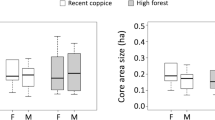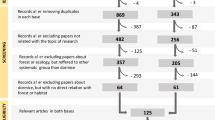Abstract
The factors influencing the presence/absence of the edible dormouseGlis glis (Linnaeus, 1766) in forest fragments in Mediterranean central Italy were investigated by performing repeated nocturnal surveys in 38 woodlots. The various woodlots were different from each other in terms of area, degree of isolation, and floristic and structural characteristics. The effects of different types of forest management and human activities on dormouse distribution were also analysed. Dormice occurred in all the surveyed high forests, while no sign of their presence was detected in coppices with a rotation cycle short (<18 years). There were significant differences between coppices and high forests, but not between grazed and ungrazed woodlots, and rotational and non-rotational forests. Correspondence analysis corroborated the empirical evidence, showing a close association between presence of dormice and high forests, and, to a lesser degree, rotational forests. Concerning environmental parameters, favourable woods were those with high trees and with low stem number, while the specific tree assemblages proved to be scarcely important. Wood area was more important than isolation in predicting presence or absence of this rodent, as the highest probability was associated with woodlots of 40–50 ha area and more. These results did not provide evidences about the importance of the amount of residual habitat in the 10 km2 surrounding the woodlot and the presence of hedgerows as ecological corridors.
Similar content being viewed by others
References
Amori G., Cantini M. and Rota V. 1995. Distribution and conservation of Italian dormice. Hystrix n.s. 6: 331–336.
Andrén H. 1994. Effects of habitat fragmentation on birds and mammals in landscapes with different proportions of suitable habitat: a review. Oikos 71: 355–366.
Beier P. 1993. Determining minimum habitat areas and habitat corridors for Cougars. Conservation Biology 7: 94–108.
Bieber C. 1995. Dispersal behaviour of the Edible dormouse (Myoxus glis) in a fragmented landscape in central Germany. Hystrix n.s. 6: 257–264.
Bright P. W. 1993. Habitat fragmentation — problems and predictions for British mammals. Mammal Review 23: 101–112.
Bright P. W., Mitchell P. and Morris P. A. 1994. Dormouse distribution: survey techniques, insular ecology and selection of sites for conservation. Journal of Applied Ecology 31: 329–339.
Capizzi D., Battistini M. and Amori G. 2002. Analysis of the Hazel dormouse,Muscardinus avellanarius, distribution in a Mediterranean fragmented woodland. Italian Journal of Zoology 69: 25–31.
Celada C., Bogliani G., Gariboldi A. and Maracci A. 1994. Occupancy of isolated woodlots by the red squirrelSciurus vulgaris L. in Italy. Biological Conservation 69: 177–183.
French A. R. 1988. The patterns of mammalian hibernation. American Scientist 76: 569–575.
Gębczyński M., Górecki A. and Drożdż A. 1972. Metabolism, food, assimilation and bioenergetics of three species of dormice (Gliridae). Acta Theriologica 21: 271–294.
Geuse P., Bauchau V. and Le Boulengé E. 1985. Distribution and population dynamics of the bank voles and wood mice in a patchy woodland habitat in central Belgium. Acta Zoologica Fennica 173: 65–68.
Hinsley S. A., Bellamy P. E., Newton I. and Sparks T. H. 1996. Influences of population size and woodland area on bird species distributions in small woods. Oecologia 105: 100–106.
Hoodless A. and Morris P. A. 1993. An estimate of population density of the fat dormouse (Glis glis). Journal of Zoology, London 230: 337–340.
Jurczyszyn M. 1995. Population density ofMyoxus glis in some forest biotopes. Hystrix, n.s. 6: 265–272.
McGarigal K., Cushman S. and Stafford S. 2000. Multivariate statistics for wildlife and ecology research. Springer-Verlag, New York: 1–283.
Morris P. A. and Hoodless A. 1992. Movements and hibernaculum site in the fat dormouse (Glis glis). Journal of Zoology, London, 228: 685–687.
Norusis M. J. 1993. SPSS for Windows — User’s Guide, Release 6.0. SPSS Inc., Chicago.
Pucek Z., Jędrzejewski W., Jędrzejewska B. and Pucek M. 1993. Rodent population dynamics in a primeval deciduous forest (Białowieża National Park) in relation to weather, seed crop, and predation. Acta Theriologica 38: 185–198.
Rodolfi G. 1994. DormiceGlis glis activity and hazelnuts consumption. Acta Theriologica 39: 215–220.
Santini L. 1978. Biology, damage and control of Edible dormouse (Glis glis) in central Italy. [In: Proceedings of the 8th Vertebrate Pest Conference, Sacramento, California. W. E. Howard, ed]. University of California, Davis, USA: 78–84.
Santini L. 1983. [Italian rodents of agricultural and forest concern]. CNR AQ/1/232, Padova: 1–168. [In Italian]
Simpson E. H. 1949. Measurement of diversity. Nature 163: 688.
Soulé M. E. (ed) 1986. Conservation biology: The science of scarcity and diversity. Sinauer Associates, Sunderland, Massachussets: 1–584.
van Apeldoorn R. C., Oostenbrink W. T., van Winden A. and van der Zee F. F. 1992. Effect of habitat fragmentation on the bank vole,Clethrionomys glareolus, in an agricultural landscape. Oikos 65: 265–274.
van Dongen S., Backeljau T., Matthysen E. and Dhondt A. A. 1994. Effects of forest fragmentation on the popullation structure of the winter mothOperophtera brumata L. (Lepidoptera, Geometridae). Acta Oecologica 15: 193–206.
Verboom J., Schotman A., Opdam P. and Metz J. A. J. 1991. European nuthatch in a fragmented agricultural landscape. Oikos 61: 149–156.
Wang L. C. H. 1987. Mammalian hibernation. [In: The effects of the low temperature on biological system. B. W. Grout and G. J. Morris, eds]. Edward Arnold, London: 349–386.
Watts C. H. S. 1969. The regulation of wood mouse (Apodemus sylvaticus) numbers in Wytham woods, Berkshire. Journal of Animal Ecology 38: 285–305.
Wauters L., Casale P. and Dhondt A. A. 1994. Space use and dispersal of red squirrels in fragmented habitats. Oikos 69: 140–146.
Author information
Authors and Affiliations
Additional information
Editor was Zdzisław Pucek.
Rights and permissions
About this article
Cite this article
Capizzi, D., Battistini, M. & Amori, G. Effects of habitat fragmentation and forest management on the distribution of the edible dormouseGlis glis . Acta Theriol 48, 359–371 (2003). https://doi.org/10.1007/BF03194175
Received:
Accepted:
Issue Date:
DOI: https://doi.org/10.1007/BF03194175




